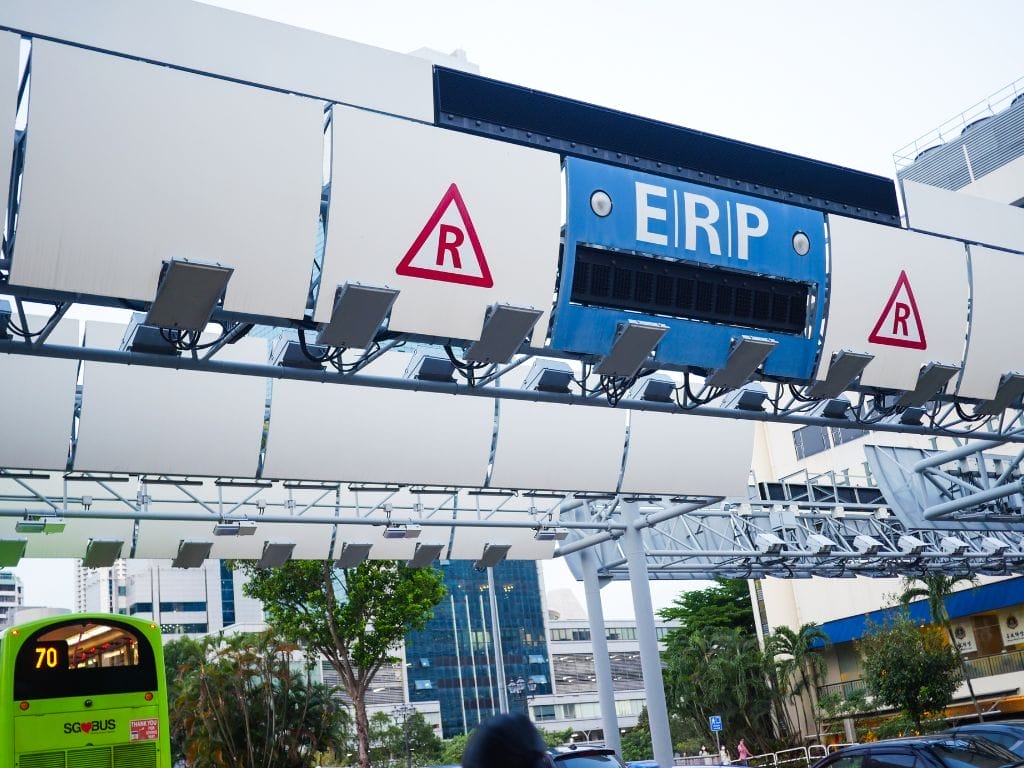10 Interesting Facts about Singapore’s ERP 2.0

No Time to Read? Here’s a Snappy Summary of This Article
- Cutting-edge Tech: Singapore unveils ERP 2.0, a revolutionary traffic management system utilizing advanced technology for efficient urban mobility.
- Dynamic Pricing: ERP 2.0 introduces dynamic road pricing, adapting fees based on real-time traffic conditions, reducing congestion and improving commute times.
- Green Initiatives: Singapore’s ERP 2.0 emphasizes sustainability, encouraging eco-friendly transportation methods and contributing to the city-state’s environmental goals.
- Smart Infrastructure: The system integrates seamlessly with smart city infrastructure, leveraging data to optimize traffic flow and enhance overall urban planning.
- User-Centric Design: ERP 2.0 prioritizes user experience, offering a user-friendly interface and personalized features to make commuting more convenient and enjoyable.
- Global Urban Inspiration: Positioned as a model for other cities, Singapore’s ERP 2.0 sets a benchmark for smart traffic management, inspiring global urban planning innovations.
Table of Contents
- No Time to Read? Here’s a Snappy Summary of This Article
- 1. Introduction of ERP 2.0
- 2. Origins of ERP 2.0
- 3. ERP 2.0 System
- 4. On-Board Unit (OBU)
- 5. OBU Installation
- 6. Features of OBU
- 7. Motorcycle OBU
- 8. Opting Out of OBU Display
- 9. Benefits of ERP 2.0
- 10. Future of ERP 2.0
- Meanwhile, Check Out Tropika Club’s Ecosystem of Websites
Introduction
Prepare yourself for a new era of road navigation in Singapore! The city-state’s Electronic Road Pricing (ERP) system, a key component of its urban infrastructure, is undergoing a significant transformation with the introduction of ERP 2.0. This isn’t just a simple upgrade – it’s a complete overhaul designed to enhance efficiency, accuracy, and user experience for motorists navigating the bustling streets of Singapore.
With ERP 2.0, you can expect a more precise and fair road pricing mechanism, thanks to the integration of advanced technologies like the Global Navigation Satellite System (GNSS). But that’s not all – the new system also promises a host of value-added services that aim to make your driving experience smoother and more enjoyable.
So buckle up and get ready for this exciting journey as we delve into the world of ERP 2.0 – a testament to Singapore’s commitment to leveraging technology for sustainable urban mobility.

1. Introduction of ERP 2.0
The next-generation satellite-tracked Electronic Road Pricing (ERP) system, dubbed ERP 2.0, is set to kick in from mid-2023 in Singapore. This new system is a significant upgrade from the current one and promises to bring about several changes to the way road pricing is managed in the city-state.

2. Origins of ERP 2.0
The Land Transport Authority (LTA) announced the introduction of ERP 2.0 as a part of its efforts to ease traffic congestion in Singapore. The new system is expected to be more efficient and effective in managing road usage and promoting a car-lite society.

3. ERP 2.0 System
ERP 2.0 is supported by the Global Navigation Satellite System (GNSS) technology. This advanced technology allows for more precise tracking and calculation of road usage, leading to a fairer and more accurate pricing system for motorists.

4. On-Board Unit (OBU)
The current in-vehicle unit (IU) will be replaced with a new On-Board Unit (OBU), which provides value-added services for motorists, such as advance alerts on charging locations and traffic updates. The OBU comprises three components – a processing unit for payment transactions, an antenna that communicates with ERP, carpark gantries and GNSS, and a touchscreen display.

5. OBU Installation
The installation of OBU will begin in phases from November 2023, starting with fleet vehicles. The OBU will be provided free of charge to all eligible Singapore-registered vehicles during the installation period. However, cars that are due for mandatory deregistration during the installation exercise are not eligible.

6. Features of OBU
The OBU display notifies motorists about ERP and payment information, as well as provides other information such as locations of nearby Silver Zones, speed cameras and bus lanes. It is also expected to support additional features like real-time traffic alerts and payment of roadside parking and tolls at checkpoints when all vehicles have transitioned to ERP 2.0.
_
Read Also:
Why Singapore is Becoming a Global Leader in Cryptocurrency
_

7. Motorcycle OBU
For motorcycles, the three components are integrated into a single-piece OBU. It includes a processing unit and a small touchscreen for riders to toggle through different functions. It will be mounted on motorcycles’ handlebars.

8. Opting Out of OBU Display
Those who wish to opt out of installing the touchscreen display may do so, and access key OBU information via compatible mobile applications on their smartphones instead. However, LTA is strongly encouraging motorists to install all three OBU components so that they are able to access the full range of features, such as paying for roadside parking.

9. Benefits of ERP 2.0
The introduction of ERP 2.0 is expected to bring about several benefits for motorists in Singapore. Apart from providing more accurate road pricing, it also offers value-added services that can enhance the driving experience and promote safer driving habits among motorists.

10. Future of ERP 2.0
As Singapore continues to evolve as a smart city, the implementation of ERP 2.0 marks a significant step forward in its journey towards becoming a car-lite society. With this new system, Singapore is poised to lead the way in leveraging technology for sustainable urban mobility.
Conclusion
As we stand on the brink of this transformative change, it’s evident that ERP 2.0 is not just an upgrade, but a revolution in the way road pricing is managed in Singapore. This innovative system promises to make our journeys smoother, more efficient, and more aligned with the principles of fair usage.
ERP 2.0 is set to redefine our driving experience, making it more seamless and less stressful. With its precise tracking and calculation of road usage, it ensures that motorists pay for exactly what they use. This not only promotes fairness but also encourages responsible road usage.
Moreover, the value-added services offered by ERP 2.0 are set to enhance our overall driving experience. From real-time traffic updates to advance alerts on charging locations, these features are designed to provide motorists with all the information they need for a smooth journey.
In essence, as we gear up for the launch of ERP 2.0, we are not just preparing for a change in road pricing. We are getting ready for a future where technology and innovation make our roads smarter and our journeys more enjoyable. Indeed, ERP 2.0 is set to revolutionize not just road pricing, but the very way we navigate the vibrant city of Singapore.

Frequently Asked Questions (FAQ)
Q: How does Singapore’s ERP 2.0 contribute to environmental sustainability?
A: Singapore’s ERP 2.0 promotes sustainability by encouraging eco-friendly transportation methods, reducing carbon footprint and supporting green initiatives.
Q: Can I customize my ERP 2.0 settings for a personalized commuting experience?
A: Yes, ERP 2.0 prioritizes user experience, offering customizable features to make commuting more convenient and tailored to individual preferences.
Q: How does dynamic pricing in ERP 2.0 benefit commuters?
A: Dynamic pricing in ERP 2.0 adapts to real-time traffic conditions, reducing congestion and improving commute times for a smoother and cost-effective travel experience.
Q: Does ERP 2.0 integrate with other smart city infrastructure in Singapore?
A: Absolutely. ERP 2.0 seamlessly integrates with Singapore’s smart city infrastructure, utilizing data to optimize traffic flow and enhance overall urban planning.
Q: How does dynamic pricing in ERP 2.0 benefit commuters?
A: Dynamic pricing in ERP 2.0 adapts to real-time traffic conditions, reducing congestion and improving commute times for a smoother and cost-effective travel experience.
Q: Does ERP 2.0 integrate with other smart city infrastructure in Singapore?
A: Absolutely. ERP 2.0 seamlessly integrates with Singapore’s smart city infrastructure, utilizing data to optimize traffic flow and enhance overall urban planning.

Have an Article to Suggest?
Tropika Club is always looking for new and exciting content to feature in their magazine and they value the input of our readers. If you have any noteworthy content or articles that you believe would be a great addition to Tropika Club’s magazine, we are open to suggestions and encourage you to reach out to us via email at [email protected]. By doing so, Tropika Club values your expertise and knowledge in the matter and appreciates your willingness to help. We will review your recommendations and update our list accordingly
Meanwhile, Check Out Tropika Club’s Ecosystem of Websites
Tropika Club Magazine – Tropika Club Magazine is a Singapore-based publication that features articles on a wide range of topics with a focus on local businesses and content for the region. The magazine emphasizes supporting local businesses through its #SupportLocal initiative, which includes coverage of everything from neighborhood hawker stalls to aesthetic clinics in town. In addition to highlighting local businesses, Tropika Club Magazine also covers a variety of local content, including beauty, lifestyle, places, eats, and what’s on in Singapore and the Asia Pacific region.



